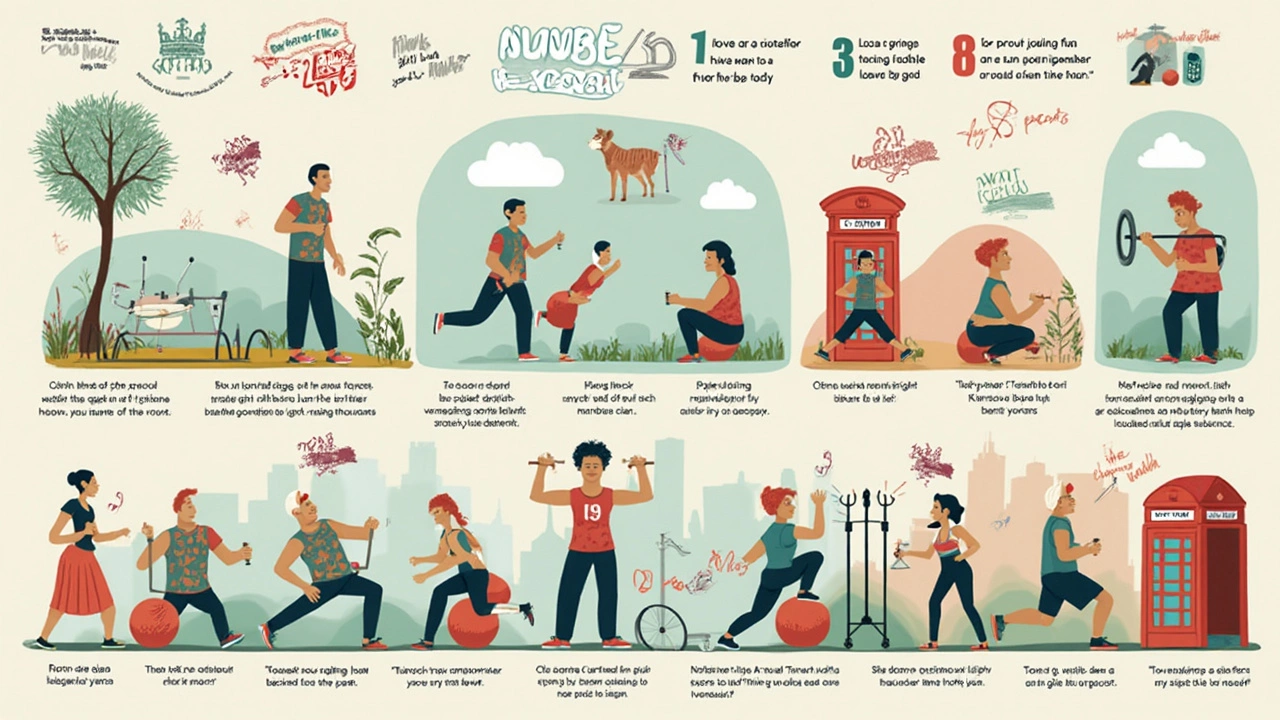
Everybody wants a straight answer: if you could only do one exercise, which one should you pick? It’s not just about burning the most calories or looking good on Instagram. The best move covers everything—strength, cardio, mobility, and works for almost anyone, anywhere.
Here’s the deal: there’s plenty of hype around flashy routines, but most trainers agree on one surprising winner. I’m talking about the humble yet powerful burpee. Sounds basic, right? Don’t underestimate it. This move streams together a squat, push-up, and jump, hitting almost every muscle group in a matter of seconds. Yes, you’ll be gasping for air, but that’s exactly why it works so well.
If you aren’t sure where to start or how to fit burpees into your routine, you’re in the right spot. By the end of this article, you’ll know exactly why this classic exercise deserves your attention—and how to make it work for your body, not against it.
- Why Pick Just One?
- The #1 Best Exercise Unveiled
- Benefits You Can't Ignore
- How to Make It Work for You
- Simple Tips and Smart Variations
Why Pick Just One?
Most workout plans throw in a bit of everything: squats, push-ups, jogging, maybe a few machines at the gym. But the question keeps popping up—what’s the best exercise when you just want to keep it simple and still see results? With busy schedules and overflowing fitness content, picking one move isn't just practical, it can help you stick to your routine in the long run.
Experts usually want you to move every muscle, and for good reason. But research shows compound exercises—those that hit multiple muscle groups at once—burn more calories, build more strength, and improve fitness faster than isolated moves like bicep curls. It’s the "bang for your buck" approach. Plus, doing just one full-body exercise cuts down on decision fatigue. You know exactly what you’re showing up for. Ever heard of decision paralysis? In fitness, picking too many options often leads people to skip workouts entirely.
Here’s another thing: Most people struggle to get the recommended 150 minutes of moderate exercise per week. If picking just one exercise helps you actually move, that’s a win right there. And you don’t need fancy equipment or a gym membership. The right move can fit in between meetings, while dinner is cooking, or even while watching TV.
| Benefit | Detail |
|---|---|
| Saves Time | No need to learn long routines |
| Full-Body Impact | Targets major muscle groups together |
| Consistency | Less planning, more doing |
| Accessibility | Works anywhere, often without equipment |
The bottom line: picking just one exercise isn’t about doing less—it’s about getting more from each minute, no matter how packed your day is. As you dig into the next section, you’ll see which move rises to the top and why it’s earned so much respect among trainers and physiologists alike.
The #1 Best Exercise Unveiled
Let’s be real: “What’s the best exercise?” is the question that pops up everywhere, and the answer almost always surprises people. It’s not a fancy Olympic lift or a complicated Pilates move. Based on tons of trainer feedback and studies, the burpee takes the crown. The secret is in its simplicity and intensity. Each rep works your chest, arms, shoulders, legs, butt, and core and throws your heart rate into overdrive. You get strength and cardio at the same time—no machines, no weights, no need for a huge space.
Burpees first showed up in the 1930s as a fitness test for the US military. Ever since, physical therapists and coaches have raved about their effect: just a few reps will leave you sweaty, even if you’re already fit. According to the American College of Sports Medicine, high-intensity moves like burpees can burn between 8 and 14 calories per minute—outpacing jogging or cycling for calorie burn. Plus, a study from 2022 found that doing short bursts of burpees improved cardiovascular fitness in only four weeks.
| Exercise | Calories Burned (15 min, 155 lbs) | Muscle Groups Used |
|---|---|---|
| Burpees | ~150-210 | Full body |
| Jogging (5 mph) | ~140 | Legs |
| Push-Ups | ~90 | Chest, Arms |
| Squats | ~75 | Legs, Glutes |
What about how to do a basic burpee? Here’s a quick breakdown for anyone, even if you haven’t exercised in a while:
- Stand with your feet shoulder-width apart.
- Bend your knees and put your hands flat on the floor in front of you.
- Jump both feet back into a plank position.
- Do a push-up (optional if you're a beginner).
- Jump your feet forward to your hands.
- Stand up and jump straight into the air, reaching your arms overhead.
This isn’t just about being tough. Burpees actually build power, improve heart health, and boost endurance all in a few quick sets. The best part? You don’t need a gym, special shoes, or any equipment. If there’s one move that delivers both results and convenience, this is it.

Benefits You Can't Ignore
So, why does the burpee always get called out as the best exercise? Simply put, it gets you strong, lean, and fit—fast. Here's what really happens when you grind through a good set of burpees.
Burpees work your chest, arms, quads, glutes, hamstrings, and abs all at once. That’s almost every big muscle group firing together. Your heart rate soars, which means you’re sneaking in solid cardio while building muscle, so double the payoff in half the time.
Trainers love burpees because they keep burning calories after you stop. This after-burn effect, called EPOC (excess post-exercise oxygen consumption), means your body uses more energy to recover. According to a 2014 study in the Journal of Strength and Conditioning Research, doing high-intensity moves like burpees can keep your metabolic rate higher for up to 38 hours.
| Benefit | How Burpees Deliver |
|---|---|
| Calorie Burn | Up to 10 calories per minute, or about 100 calories in 10 minutes for most adults |
| Muscle Groups | Total body: legs, arms, core, chest, and back |
| Cardio Boost | Significant increase in heart rate, improving VO2 max over time |
| Space & Equipment | No gym required, just a few feet of space |
| Time Efficient | Gets max results with brief, intense sessions |
If you’re stuck at home or in a tiny apartment, you barely need any space. No need for a fancy kettlebell or resistance band—just your body. In fact, studies out of ACE (American Council on Exercise) found burpees consistently deliver top-tier fitness improvements in less than 15 minutes a day.
The best part? Anyone can modify them to their level. Can’t jump? Step out instead. Push-up too tough? Drop to your knees. But no matter how you do them, you’re building real-world fitness that actually matters outside the gym—moving, lifting, running, playing with your kids, or just getting up off the floor faster. That’s a win.
How to Make It Work for You
Jumping into burpees doesn’t mean you have to crank out reps like a bootcamp drill sergeant. The trick is making this best exercise fit your current fitness level and goals. Success isn’t about doing the most in the shortest time; it’s about moving well and staying consistent.
If you’re new to burpees or just coming back from a break, start slow. Here’s a simple way to ease in:
- Skip the push-up: Just drop into a plank instead. Less stress on your shoulders and wrists.
- Step back instead of jumping: This lowers impact and gives you time to control the movement.
- No jump at the end? Totally fine. Just reach for the ceiling to finish each rep.
If you want more intensity, try these versions:
- Add a push-up every time you hit the floor.
- Pick up the pace and go for speed. Set a timer for 30 seconds or one minute, and bang out as many clean reps as possible.
- Hold a pair of dumbbells or use a weighted vest for more resistance (just make sure your form doesn’t break down).
Bored of basic burpees? Mix things up. Add a tuck jump instead of a regular jump, or throw in a mountain climber between steps. These small tweaks challenge different muscle groups and keep your sessions interesting.
Wondering how often to do burpees? Here’s what fitness studies have shown: doing high-intensity full-body exercises like burpees just 3 times a week can boost endurance and strength in under a month. Want numbers? This table shows what just a few sessions a week can do, based on research from the American Council on Exercise:
| Burpee Workouts Per Week | Improvement in Cardio Endurance | Improvement in Muscular Strength |
|---|---|---|
| 1-2 sessions | Noticeable but slow | Mild to moderate |
| 3-4 sessions | Fast improvement (within 2-4 weeks) | Significant gains |
| 5+ | Risk of burnout/injury grows | Plateau likely |
Keep it smart: don’t do burpees every day forever. Mix them into your weekly plan with rest or lighter workout days. If your knees, wrists, or lower back start complaining, scale back and focus on easier variations. Quality over quantity wins every time.

Simple Tips and Smart Variations
If you’re just getting into burpees or want to crank things up, there are some tricks and twists to make them work for you. First, it’s not about blasting through a hundred reps—good form beats speed, especially for avoiding injuries. Keep your core tight, land softly on your feet, and make sure your chest actually touches the ground on each rep.
If regular burpees feel tough, scale down. Step your feet back one at a time instead of jumping or drop the push-up altogether. Too easy? Try adding a tuck jump at the end or grab some light dumbbells for an extra challenge. You can also play with intervals. Do 30 seconds on, 30 seconds off, or try EMOM (Every Minute on the Minute): set a number—say, 10 burpees—and aim to finish that many at the start of each minute, resting for the remainder.
Here are a few popular burpee variations to mix things up:
- Best exercise burpee: The classic combo (squat, plank, push-up, jump)
- Half burpee: Skip the push-up and just jump your feet back and forward
- Burpee broad jump: Instead of a straight-up jump, leap forward for more legs
- Box burpee: End with a jump onto a sturdy box or step for even more explosive power
- Mountain climber burpee: Add 4 mountain climbers in the plank position before your jump
The U.S. Army physical fitness test once included burpees and clocked the average person hitting 10-15 in a minute with good form. To show the challenge, here’s what you burn on average, according to numbers from Harvard:
| Body Weight | Calories Burned (10 mins of burpees) |
|---|---|
| 125 lbs | 80 |
| 155 lbs | 100 |
| 185 lbs | 118 |
If you’re tracking progress, aim to add one or two reps or a new variation each week. It keeps things fresh and lets your body adapt without burnout. Trust your limits, listen to your joints, and be patient—burpees aren’t meant to be punishment. They’re a tool to help you get stronger and more confident every time you hit the floor.
